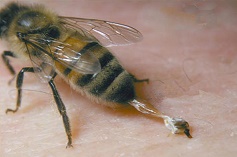| When people find out I grew up on a bee farm, one of the first questions I get is “Have you been stung?” And I tell them far too many times to remember. My rough estimate is between 1,000 and 2,000 times over 10 years. It wasn’t unusual to get stung ten times in a day. Now that I’m in the city, I don’t get stung much but one day last fall, I did get stung four times. Admittedly, that was after I had been through the hive a third time on a cool, fall day looking for the queen (you could say I was pushing my luck.) Before that day, I was at the pointy end of the bee a grand total of two times over two summers with my itsy bitsy city hive. | |
| The infrequency of my stings in the city isn’t because I’m all geared up. Usually all I’m wearing is shorts and a T-shirt – no veil, no gloves, no coveralls. Sometimes even no shoes. It is because I can do my beekeeping on nice days, because I’m calm and because I’m working with a gentle strain of bees. On my family’s farm they have a strict policy that if a bee hive seems cranky, the queen gets pinched, so over many years of queen breeding they have developed a gentle strain. | |
 Honey bee after stinging. Note stinger and attached venom sac stuck into the skin and ripped away from the rest of the bee’s body. |
While we are on the topic of bees stings, I should mention that a widely held view is that only getting a few stings is a good way to develop an allergy to bee stings. One beekeeper I know even goes so far as to mash the venom sac and pump attached to the stinger in so that he gets even more venom because he wants to build up his immunity. With a little micro hive there’s more risk you’ll be stung too little than too much, so try to get stung lots (at least on the hands and arms). This summer, that will be my objective. |
| Lots of people will tell you they are allergic to bee stings. It is important to understand the difference between an allergy and just a reaction to the venom. If you get stung on the hand and your hand, wrist and even your arm swell up, even if it lasts for days, that’s not an allergy, although it can be quite painful. However, if you get stung on the hand and your throat starts feeling ‘itchy’ or if you get hives on your chest or it becomes hard to breathe, that is an allergic reaction. The rule of thumb is if you are having pain and swelling near the place of the sting it’s not allergic, but if the reaction is nowhere near the place of the sting, it probably is an allergy. The Mayo Clinic has this guide. In case you’re wondering why it hurts, the venom injected by a bee sting is a toxin more powerful than some snake venoms. But as Paracelsus said, “The dose makes the poison” and the amount of venom injected by a bee sting is very small (only 5 – 50 micrograms). In extremely rare cases you can be stung so many times that the dose is enough to make the bee venom toxic – it’s not an allergic reaction, but still could kill you. But relax, you’d pretty much have to knock over a hive to get that many stings. | |
- Comment
- Reblog
-
Subscribe
Subscribed
Already have a WordPress.com account? Log in now.



AHAH! Finally someone that has some kind of solution. I recently got my first multiple stings and became bee shy even though I’ve kept bees for several years. Now I’m remembering that one of my hives was stingy from the get-go, and when they swarmed that didn’t change. Replace the queen. okay, thank you.
Just make sure that if you’re requeening, you’re doing so with a queen selected from gentle stock